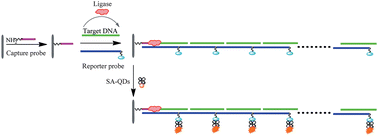Quantum dot-based isothermal chain elongation for fluorescence detection of specific DNA sequences via template-dependent surface-hybridization
Abstract
A new quantum dot-based method to detect specific sequences of DNA is proposed. The capture and reporter probes do not hybridize to each other, but in the presence of a template they can anneal to each other via the formation of a stable ternary complex. Because of the specific design of the capture and reporter probes, the 5′ end of the template target DNA remains free to hybridize with another reporter. In this way, each capture DNA is an initiator strand that triggers a cascade of hybridization events between the target DNA and the reporter probe. This forms a superstructure, enhances base stacking, and produces a strong fluorescent signal. The introduction of T4 DNA ligase further stabilizes the superstructure and greatly increases the fluorescence intensity, and the detection limit is as low as 10 fM. This fluorescence method is advantageous over conventional techniques because of its excellent ability to discriminate single base-pair mismatches and single nucleotide gap or flap. This simple technique is promising for improving medical diagnosis and treatment.


 Please wait while we load your content...
Please wait while we load your content...